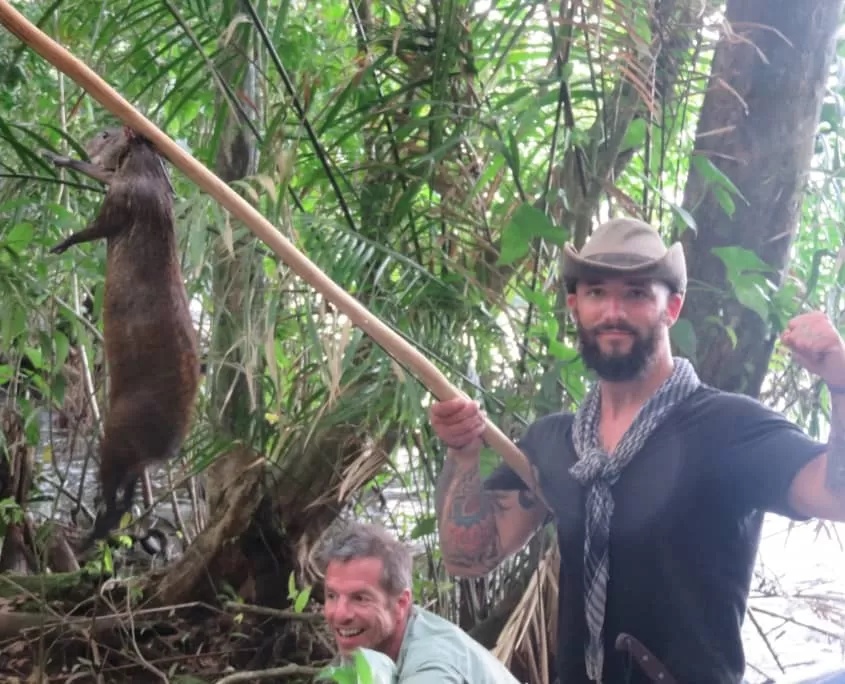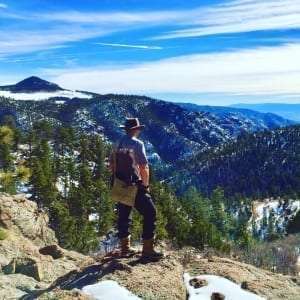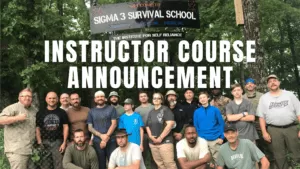Jungle Survival, Living Off the Jungle, Wild Foods, and Jungle Bushcraft
Numerous SIGMA 3 cadre have just returned from a jungle survival trip deep in the Nicaraguan jungles and have gained an awesome sense of empowerment knowing how well they can live in the jungle with a few tools. This October 2015 we set out on a jungle survival trip to practice bushcraft with the Rama Indians in the Southeastern section of Nicaragua, near the little town of San Juan Del Norte. This is the last stop when traveling into the jungle where there is nothing but indian settlements along the river.
We took an epic multi-day trip up the Indian river to get us into the deepest jungles we could find. We wanted to see what the jungle really had to offer in the way of food and we weren’t let down. These jungles are literally a treasure trove of food, resources, fish, wild meat, and the best diversity of wild plants anywhere! You can literally eat like a king in these jungles and have want for nothing. Jungle survival can be so easy with the right skills and few tools.
Shelter
The jungle trees provide such great leaves for providing thatched roofs that with the right knowledge you can thatch a roof that will withstand hurricane level rains. The royal palm is so amazing to work with and a roof can be thatched quickly that is totally waterproof. There is no doubt that this is one of the easiest places on the planet to survive. It’s really refreshing to enjoy a place with so many resources for bushcrafting that it makes life simple. The vines of the jungle are a wonder to behold because they are like free rope everywhere you look. Vines of all sizes and strengths can be found in overwhelming abundance. These vines are strong enough to lash any shelter and build almost anything you can imagine. The abundance of them is so staggering that you almost don’t even need to bring much cordage with you.
We built several types of jungle survival shelters during our time in the jungle and by far my best learning experience was helping construct this traditional hut. The uses of Royal palm are almost to many to mention and it makes the most wonderful thatched roofs. It is what all the homes are thatched with to include the Rio Indio lodge and you would be surprised at how well a thin layer of palms can repel water.
We also thatched with other palm types like the Sweeta palm which is abundant all over the jungle. This type of palm leaves proved to be extremely easy to use as well because of the way we thatched them. These leaves easily made a waterproof shelter in very little time at all. You can complete shelters in literally a 1/3 of the time you can most typical survival shelters in the United States. It really made life easy to have these plants everywhere you look so you could just whip up a jungle survival shelter at will.
where most of the resources are located.
Water
There was no lack of water in the jungle that is for sure but it can be difficult to find in certain places. It’s always best to stay close to the rivers but sometimes overland travel doesn’t allow that. Best plan of attack for water procurement is to just have a good sawyer filter or two. We used a camp sized gravity filter for most of our water needs for the group and it worked well for what we needed. If primitive skills is all you have then you’ll have to find a patch of bamboo to make a container and boil some water up. Always stay close to the rivers because they are the highways of the river and where most of the resources are located.
Fire
Most people think the jungle is a very difficult place to get fire in the jungle and it can be if you don’t have some basic skills. The jungle has so many so woods that if dry are fantastic fire starting materials. These soft river woods are perfect for friction fire kits but it can be difficult to find a dry piece to use immediately for bow drill. The great thing about the jungle survival is there is palm everywhere and dry palm can almost always be had for quick cooking fires. Long burning fires are not needed down there and it is to difficult to burn them indefinitely anyway. Usually the only thing you need fire for is cooking and boiling water. A lot of people think that smoke will keep away bugs but it will only knock down the number of them minimally at best. Using fire is not a great method for dealing with bugs and you shouldn’t depend on the ability to repel mosquitoes naturally as your only method for dealing with them. Rubbing mud on your body also doesn’t help much in reducing bug bites.
Food
Food was by far the easiest thing to get in the jungle and with some good survival skills you can actually get fat in the jungle. This is one of the few places on the planet where you could go totally vegetarian for months if needed. Very few places on the planet can boast this kind of food diversity. The easiest thing to get besides wild edibles is definitely fish because they are in great abundance in any riparian area you find.
While down there we ate all types of fish to include: Snook, Rainbow Bass, Brim, and much more! The preferred method for cooking it was to de-scale it then make small cuts in the flesh all up and down the fish. Then we would season it and either grill it or wrap it in palm leaves and steam it. The snook was by far the best fish I have ever eaten in my life and I’ve been fishing since I was 3 years old.
There is also a bounty of red meat to be had and we had not problem getting large rodents like the Agouti. The Agouti is like a mix between a giant rabbit and a large rat; the meat tastes similar to steak with a chicken like texture. These rodents and many others are in great abundance all over the jungle.
Tools
Really the only modern equipment you need in the jungle is a good machete, tarp, mosquito netting, water container, and fire tool. But you can survive easily with nothing more than a machete if you have good bushcraft skills. What surprised me in the jungle was just how soft the wood was and how even a dull machete will quickly fly through large trees. This is an environment where you truly can walk into with just a blade and survive like a king.
The single most important luxury jungle survival tool I took with me was definitely my Warbonnet Blackbird XLC. We had numerous people with Clark hammocks while there and they are the most expensive hammock system you can get. They were all jealous of my Warbonnet hammock because it is much larger, more comfortable, and has way better bug protection. I stayed in the Clark hammock just to try it out for awhile and it was so small it felt like a coffin. I personally do not like them at all and all the guys that tried our Warbonnets now own them lol. A lot of the guys using Clark hammocks got bite up on there back by mosquitos because it is only one layer, while the Warbonnet is a double layered bottom that prevents bug bites. I spent a lot of time in my hammock at night because it gets dark there about 5:30 pm and everyone goes to bed early during the rainy season. So being comfortable in miserable conditions was a life saver! Never got wet or bug bite once over a 2 week periods in some tough jungle inside my Warbonnet Hammock system. We have more reviews of using it doing jungle survival coming soon!
Where can I get a Warbonnet Hammock? Click Here!
Jungle Tarp Making
Probably the most amazing piece of equipment I saw while in the jungle was a homemade tarp. It was simply a bed sheet that had been coated with the latex of the rubber tree and this substance turned the sheet into a totally waterproof tarp. It was amazing how they had a process to make waterproof tarps as good as our modern equivalent and they did it almost completely primitively.
Dangers
The jungle may be a haven for bushcraft resources but it is definitely a very dangerous place to survive. The biggest jungle survival danger is by far and away the wild hogs and the monster herds they roam in. These herds of hogs will roam in numbers of excess of a thousand animals and they are very aggressive. These aren’t the large hogs like we have in the United States, they are a smaller Peccary sized hog that usually won’t get over 100 lbs. Don’t let the size fool you though because what they lack in size they make up for in numbers.
One of the Rama indians told us a story about how he was hog hunting and witness a full sized jaguar get attacked and completely eaten by hogs. The jaguar killed 14 hogs right before his eyes but they eventually overwhelmed the jaguar. The same Rama guide also told us a story of how he was attacked and his leg mauled by a large hog. These animals are not to be trifled with and when you see them it is time to start climbing a tree. Don’t wait for them to get aggressive, you start climbing as soon as you see them. They also have this crazy technique to get you out of the tree once your in it that you need to be aware of. The hogs will gather in mass under the tree and begin to urinate everywhere. This causes massive amounts of ammonia to filter up into the tree tops and will cause you to pass out. They use this technique when hunting other animals that run into the trees and it is very effective. When hundreds of hogs pee in the same spot, you need to be tied to the tree in case you pass out.
Other animals to worry about are the man eating crocodiles, bullet ants, army ants, numerous poisonous snakes, mosquitoes, and poison frogs. Even though there is a lot of animals that can kill you in the jungle, its a great place to survive!
Conclusion:
This was the absolute best trip of all the participants lives and the adventure factor can’t really be rivaled anywhere else. You can catch epic sized fish, explore remote jungles, live off the land like kings, and bask in the beauty that is the jungle. Jungle survival isn’t hard with the right guide and some basic training. If you want some real adventure in your life for a reasonable price. We can book custom trips for you anytime of the year. If your interested then just click below!
FOR MORE INFO ON JUNGLE SURVIVAL ADVENTURES!
This post may contain affiliate links which means I may receive a commission from purchases made through the links. I only recommend products I personally use and love, so if you support what we are doing, thanks for clicking.










